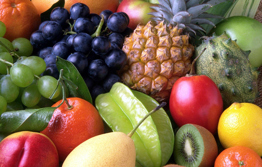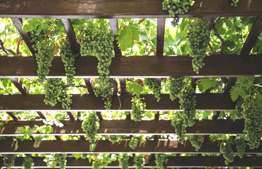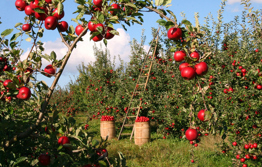Parashat Ekev: On Rain and Relationship

How the Land of Israel's dependence on rainfall facilitates an ongoing relationship between Jewish farmers and G-d in the Hold Land. Plus: a look at a 2,000-year old irrigation system still in use in Israel today.
"For the land that you are about to enter and possess is not like the land of Egypt from which you have come; there the grain you sowed had to be watered by your feet, like a vegetable garden. But the land you are about to cross into and possess, a land of hills and valleys, soaks up its water from the rains of heaven." (Devarim 11:10–11).
These verses from our parasha are puzzling: the only place in the Torah where the Land of Israel is compared to its neighboring country, the comparison is not—as we might expect—related to its sanctity; rather, it is merely agricultural. The uniqueness of the Land of Israel, according to these verses, lies only on the type of farming. While the Land of Israel's neighboring countries, west and east—Babylon and Egypt—are plains, irrigated by river water, canal-based farming (chakla'ut shelachin), the Land of Israel uses dryland farming (chakla'ut ba'al, ba'al agriculture; based on the ancient idol worship of the ba'al, believed to be in charge of rain. This sheds light on the showdown between Eliyahu HaNavi and the prophets of the ba'al on Mt. Carmel).
The difference, though, is much more profound. Dryland farming creates a dependency between the farmer and the rain from heaven. Rainfall, unlike the Nile and Tigris rivers, whose waters flow all year long, is not in human hands, but in the hands of G-d alone. The Land of Israel, as it were, forces the farmer to raise up his eyes to the heavens in supplication, ten tal umatar livracha, "provide dew and rain of blessing." Divine providence is not felt metaphorically in Israel, but in a most tangible way throughout the farmer's every day routine.
This sheds light on the condition we read twice a day in the Shema: "If you obey the commandments … I will grant the rain for your land in season" (Devarim 11:13–14) and the warning "Take care not to be lured away to serve other gods … for the L-rd's anger will flare up against you, and He will shut up the skies so that there will be no rain" (ibid., 16–17). In short: G-d is telling the Jewish People: you are about to enter the Land of Israel, where the relationship between us will forged through the rain. If you keep My mitzvot, I will bring rain, and our relationship will remain intact. If not, I will stop the rain and our relationship will be severed. Do you want to preserve our relationship? You need only to pray to Me—pray for rain.
One of the places where we can see the title of this article come to life is Nahal HaMa'ayanot, situated between the villages Hassan and Battir in the Judean hills, less than 5 km southwest of the Biblical Zoo and near the Haredi settlement Beitar Illit. Here we can see, even today, the culture of ancient farming practices as it existed in Second Temple times, referred to in the Tanach, Mishna, and Talmud.
The name of the wadi is based on the eleven springs, whose waters irrigate the farmland, situated along its length. If we stand above the vegetable patches, we can clearly see how the canal-based agriculture worked—the farming technique that marks Israel's neighboring countries. The waters of these springs accumulate in the reservoirs built alongside them. The sides of the reservoir have openings from which water can be diverted to the canal irrigation system. These canals form a network, covering the entire valley. The spring water flows through these canals to the plots of land, set up on man-made terraces. This is where the term chakla'ut shelachin originates—water is diverted to the shelach hamadrega (tread of the stairs); or from the word sholchim, as the water is sent forth. Alternatively, Rambam (gloss on Mishnah, Shevi'it 2:2) explains shelachin as shelhin, a land thirsty for water; shelhi, means tired. When the water reaches the first vegetable patch, the farmer opens the side of the canal and the water streams in, flooding the entire patch. After the patch is watered sufficiently, the farmer closes this opening and makes another opening leading to the next row; and so forth. When all the plots are watered, the farmer closes all the openings in his property, and the water flows back to the main canal to the next family's plot. The gate that either opens or obstructs the passage of water, called a govel (from the word gevul, border), is essentially a big round stone (or a clod of earth) and it is moved back and forth by one's foot—just as the Torah writes: "watered by your feet."
Of course, there is a huge difference between the canal farming in Israel and that in Egypt and Babylon. In Israel, even the canal farming is dependent on rainwater, which fills the springs alongside the stream. The source of these springs is rainwater that trickles down into the earth, which then reaches a layer impermeable to water. This layer stores the water and feeds the springs. If one walks along the cliff overlooking the springs, one can clearly see how the size of the farmland is commensurate to the flow of the spring. Most of the springs in the Judean hills do not have a strong flow, so the plots of farmland are small. The advantage of this system, though, is that water is present all year round.
We can see extensive halachic references made to this system of terraced canal farming, and the problems that might arise in shared ownership of the irrigation water. We see, for instance, in the Tosefta (Bava Metzia 11:11) describes situations when a problem occurs at different junctures in the canal with five terraces, ruling that whoever the problem affects needs to fix it: if the problem occurs in the first juncture, all plot owners need to participate, while if farther down the line, only those who the problem affects need to pay.




